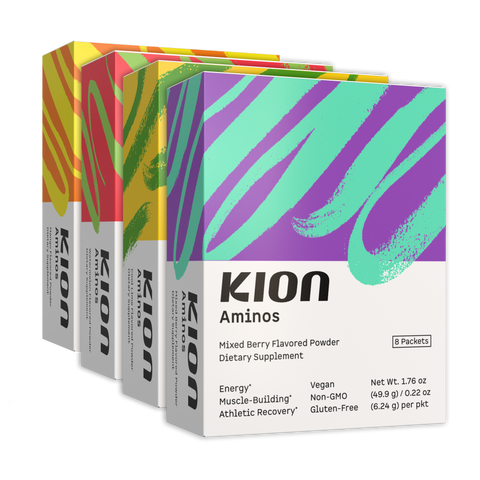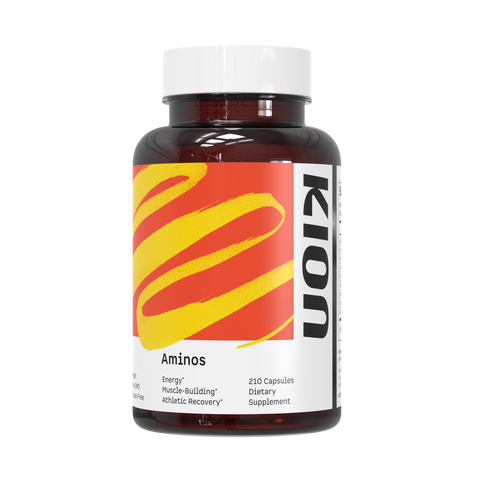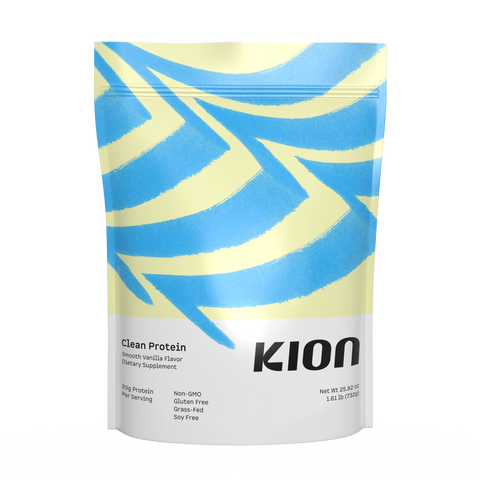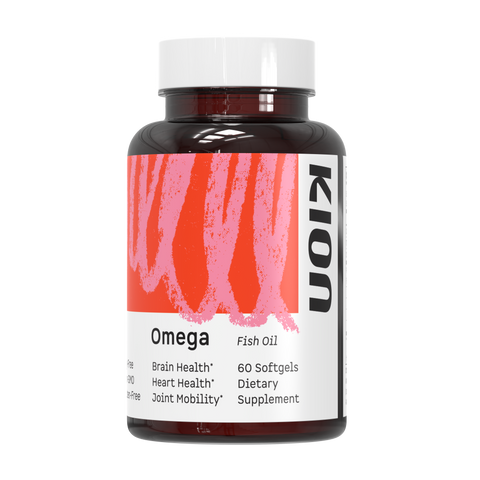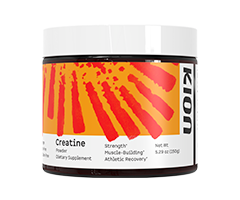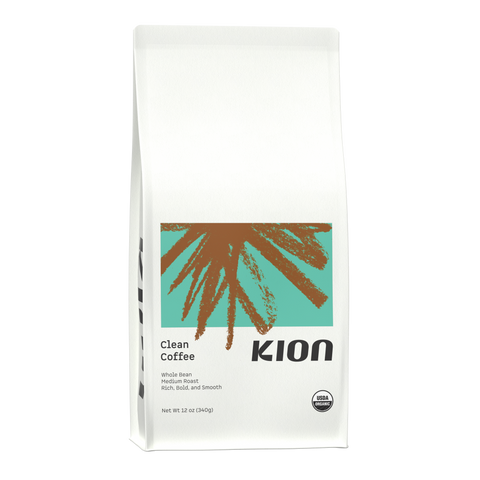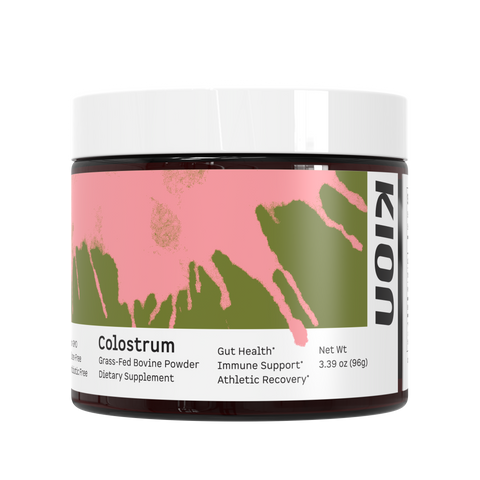Questions? We have answers.
Aminos
Yes. Aminos can be taken at any time and are especially important to take when your body’s demand for essential amino acids (EAAs) has increased. This can include periods of fasting or times when you aren’t getting enough EAAs from your diet, such as with a low-protein meal or in between meals.
Kion Aminos is a formula of free-form essential amino acids. While essential amino acids are the active component of protein that stimulates muscle protein synthesis, they are not technically a protein. At Kion, we use the FDA’s 4-4-9 rule to determine the caloric content of our products. This allows for reporting four calories per gram of carbohydrates, four calories per gram of protein, and nine calories per gram of fat. Since Kion Aminos does not contain protein, as determined by the FDA, we do not account for calories on our Kion Aminos supplement facts panel.
There is no evidence to suggest that taking Aminos would have a negative effect on one’s kidneys. In fact, because taking Aminos allows your body to reuse NEAAs (rather than digest new NEAAs from whole food protein sources) urea production by the liver is reduced, thus easing the burden on the kidneys to excrete additional urea and ammonia.
The FDA has classified EAA supplements as Generally Regarded as Safe (GRAS). The Food and Nutrition Board of The National Academy of Science published an extensive report which found no risk or negative side effects from EAA consumption, including determining that there was no apparent upper limit of safe consumption. However, we recommend taking no more than 15g at a time and spacing doses at least 3 hours apart. This is because taking more than 15g per serving, or more frequently than 3 hours apart does not offer any additional benefit in terms of muscle protein synthesis.
Essential amino acids are the active components of protein. The reason we eat protein is to supply our body with the amino acids it needs to create its own proteins, repair damaged proteins, and build and repair muscle. When assessing the quality of a particular protein source, it’s helpful to consider three questions: 1) How digestible is the protein? 2) How many total EAAs does it have?, and 3) What are the proportions of those EAAS? Aminos is extremely digestible because it is rapidly absorbed into the bloodstream, whereas protein from food needs to be broken down and digested much more slowly. Aminos contains 100% EAAs, whereas even high-quality proteins contain only about 45% EAAs. (Most lower quality and plant proteins contain significantly fewer EAAs.) Finally, the proportions of EAAs in Aminos were meticulously calculated using over 20 years of the best clinical research on amino acids. It is for all these reasons that Aminos triggers MPS to an even greater degree (at least 3x more) than whole food proteins. However, Aminos is not meant to replace whole food protein sources altogether, but to supplement the body’s need for EAAs.
Essential amino acids naturally boost energy, without caffeine or other stimulants, in five very important ways: By supporting the development of new mitochondria and the quality of existing mitochondria for improved overall energy production. Similar to fasting, caloric restriction, and exercise, EAAs stimulate the eNOS-PGC-1a-mediated mitochondrial renewal mechanisms. By assuring efficient energy production by supporting mitochondrial biogenesis, dynamics, and clearance of damaged mitochondria by mitophagy. By providing direct sources of energy in the form of fatty acids or ketone bodies. Specific amino acids can be catabolized to acetyl-CoA or acetoacetate and lead to the production of fatty acids or ketone bodies. By preventing muscle fatigue by reducing the amount of muscle breakdown. When we have all 9 EAAs circulating in our bloodstream, there is no need for EAAs to be pulled from our muscle. By reducing mental fatigue based on the central fatigue hypothesis. Three of the EAAs, leucine, isoleucine, and valine, are thought to counteract the increase of 5-HTP in the brain and its subsequent increased production of serotonin. It is also postulated that these three EAAs in particular may increase the amounts of other novel excitatory neurotransmitters.
Creatine
A loading phase is not required for Kion Creatine. Creatine loading may cause a minor increase in strength and body weight due to water retention. However, daily supplementation over a longer period has been shown to give similar results.
No, you do not need to cycle creatine. It can be taken on a daily, long-term basis.
This is a common concern with creatine supplementation. If taken in high doses, creatinine levels may be above normal which can be a sign that kidney health is compromised. However, long- and short-term studies have found that creatine doses ≤10g/day don’t impair kidney health in people with healthy kidneys. More long-term research is needed for those with compromised kidney health. If you have a history of kidney issues you should speak with your doctor before supplementing with creatine [https://examine.com/nutrition/does-creatine-cause-kidney-problems/].
It’s possible, but not likely. One study linked creatine supplementation to an increase in DHT, a hormone linked to hair loss. But this study has not been replicated [https://www.ncbi.nlm.nih.gov/pubmed/19741313]. Many other studies have shown that creatine does not affect testosterone levels, a precursor to DHT. To this day, no studies have directly examined creatine’s effects on hair loss.
Stomach cramping from creatine, while rare, can happen if you don’t drink enough water. Additionally, when too much creatine is taken at once (>10g), it can cause diarrhea and nausea. If you experience these issues, try spreading out your doses in the day or taking your creatine with meals.
Creatine may cause gains in lean mass through water retention. While higher loading doses can cause water retention that may exceed five pounds. Lower doses can cause minimal weight changes outside of gains in muscle mass.
Creatine stimulates mTor production, which can impact a fast. It may be best to avoid fasting for anti-aging purposes. However, Kion Creatine does not contain any calories or added sugars and has not been shown to spike blood glucose levels [https://www.ncbi.nlm.nih.gov/pubmed/12624482]. Therefore, it’s safe to take during fasting for other purposes such as improved cognition or body composition. When combined with Kion Aminos, it’s an incredible source of energy for fasted workouts!
Omega
Our fish is sustainably sourced from anchovies in pristine ocean waters off the coasts of South America. We harvest our anchovies in compliance with the Global Standard for Responsible Supply and National Fisheries Health Service.
The other omega-3s include: Stearidonic Acid (STD), Arachidonic Acid (AA), Eicosatetraenoic Acid (ETA), Heneicosapentaenoic Acid (HPA), Docosapentaenoic Acid n6 (DPA n-6), Docosapentaenoic Acid n3 (DPA n-3).
Triglyceride form is how omega-3s are naturally found in fish. It’s been shown to be one of the most bioavailable forms of fish oil, with absorption rates up to 70% higher than other forms.* Ethyl ester forms of fish oil are created synthetically by removing the glycerol backbone of the triglyceride, often in order to manipulate EPA and DHA levels.
Fish oil is best absorbed when taken along with food. The time of day doesn’t appear to matter, so take it with whatever meal is convenient for your lifestyle.
Yes, we regularly test our fish oil for lead, arsenic, mercury, and cadmium.
The rich, red color comes from the astaxanthin, which is a natural preservative in our fish oil. Astaxanthin is a carotenoid that gives fatty fish its pinkish-red color.










